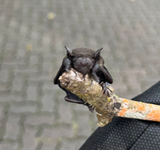Beyond the Belfry: A Look into Bat Rescue and Coexistence Efforts
- Animal Concerns Research & Education Society

- Apr 17, 2024
- 4 min read
Updated: Jan 8
Article by Karina Lim, ACRES Wildlife Coordinator
April 2024
At night when our bustling city goes to sleep, bats emerge from their hidden roosts. Unbeknownst to many and hidden in plain sight, they have always been living amongst us in trees and in roofs. They mostly mind their own business. However, our green city means that your home might be close to trees where bats love to feed on fruits, insects, or nectar. If there are conducive spots within your estate, these bats may roost there after a night of feeding. Like our guardians of the night, they watch over the delicate balance of our ecosystem. Fruit bats serve as important pollinators for the beautiful flowers in our City in Nature. These stewards of nature also unwittingly disperse and carry fruit seeds to new locations. Insect-eating bats became unseen hunters, using echolocation to pinpoint their prey. They maintain the insect population, including keeping us safe from vampires of the insect world – mosquitoes. Commonly misunderstood, it is important to appreciate bats for what they do for us. They are shy creatures and there have been no known or reported cases of diseases transmitted from bats to humans in Singapore.
NParks has been closely monitoring the local bat population. To date, their biosurveillance programs have not detected any transmittable zoonotic diseases, including COVID-19, in our bats.
As they soar with effortless grace, our bat friends might find themselves in peril sometimes. That’s when they need your assistance, to aid them in their hour of need. Sometimes, their plight goes unnoticed by the hustle and bustle of human activity surrounding them, and it is with awareness and compassion that we can become empowered to lend a helping hand.
A unique challenge befalls insect bats, such as Javan pipistrelles. Grounded by collisions or disorientation amidst the maze of human structures, some of them might find difficulty taking flight from the ground. Their delicate wings, though nimble in the air, lack the strength to generate sufficient lift for a vertical ascent. Without the elevation of a tree branch or other high perch, they can only languish on the ground with dehydration and starvation looming ominously.
I am an adult insect bat, not a baby bat! I require your help to save me from being grounded.
Baby bats, small and vulnerable, sometimes get separated from their mother in the confusion of the night. For the best chance of survival, they should be returned to the embrace of their mother where they can grow up under her watchful guidance. With the inability to fly, regulate their body temperature and find their own food, every passing moment is crucial. Our wildlife rescue officers attend to cases where we help lost babies find their mothers. Often, the mother manages to pick up her baby and fly off! See one of our successful cases below!
Should baby bats, unfortunately, fail to be reunited with their mother, timely intervention would be crucial to ensure that they get a second chance in life. In November last year, ACRES successfully released our first-ever hand-raised fruit bat. This bat spent his 3 months at ACRES transitioning through several enclosures to strengthen his flight muscles and was exposed to various wild diets. Post-release, we monitored him, and he brought a wild friend back to visit! We hope he’s doing well snuggling with a colony now.

This was when he was rescued in August 2023, fed by the caller. We thank all our callers for their kindness and compassion but please do not feed wild animals you help to rescue! The food might not be their natural diet or they might not be well enough to take food at the moment. Get in touch with our rescue hotline and we will advise on the best course of action.

We introduced a fake sock colony to keep him company.

He came back with a friend!
Other rescue cases include bats whose wings get torn accidentally. Watch the following video to find out how we managed to treat one such bat with several weeks of cage rest and careful monitoring, where the bat's wing healed and he was able to be successfully returned to the wild.
Other obstacles bats face in our concrete jungle include getting stuck in netting, such as this case (video below) where we managed to save 3 fruit bats from getting entangled. Our rescue officers carefully rescued the bats and the resident agreed to remove the netting after that incident.
A little help can go a long way! These rescues cannot take place without our compassionate callers, who help to notify us when an animal is injured or in distress. You may do so through contacting our 24-hours Wildlife Rescue Hotline, at 97837782. Do contact us or NParks Animal Response Center at 1800 476 1600 whenever you see wildlife in need of help.
For more tips on how to coexist with bats and what to do when they are roosting in your homes or eating your fruits, please refer to the ACRES Coexistence Handbook or read the advisories available right here on the Our Wild Neighbours website. A little compassion and understanding to show these small creatures some kindness would be invaluable to aid in our quest to coexist with wildlife in our City in Nature!
 | Website: acres.org.sg YouTube: www.youtube.com/@ACRESSG Facebook: www.facebook.com/ACRESasia Instagram: www.instagram.com/eyesofacres TikTok: www.tiktok.com/@acressingapore 24-hr Wildlife Rescue Hotline: 9783 7782 |
Visit our bats information page and download our advisory to get tips on what you can do when you encounter one:







Comments